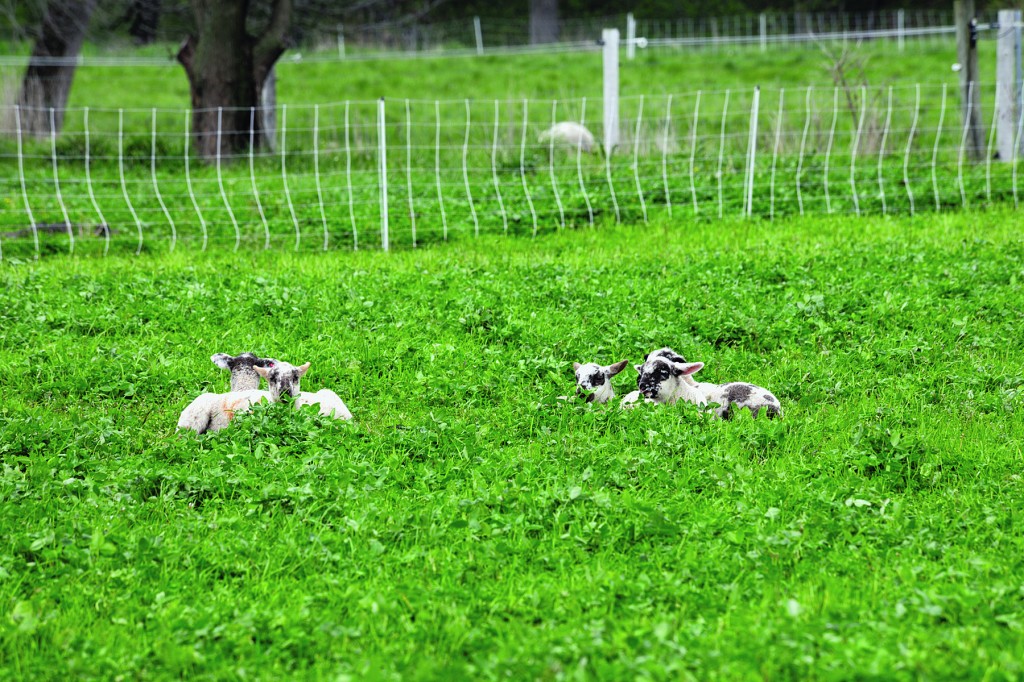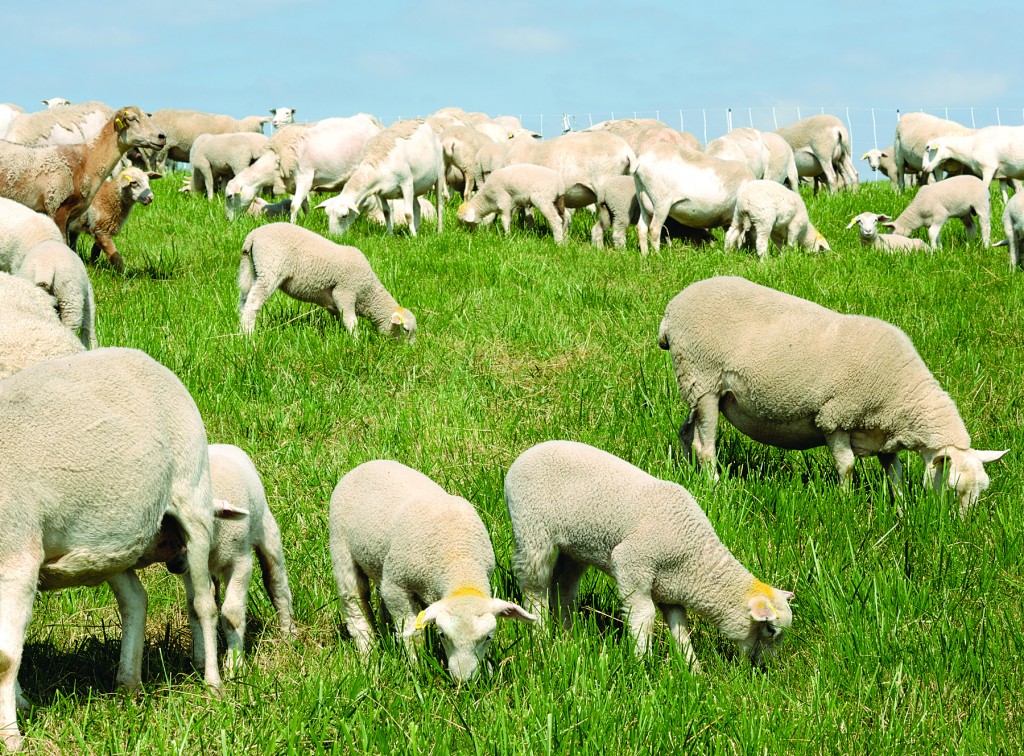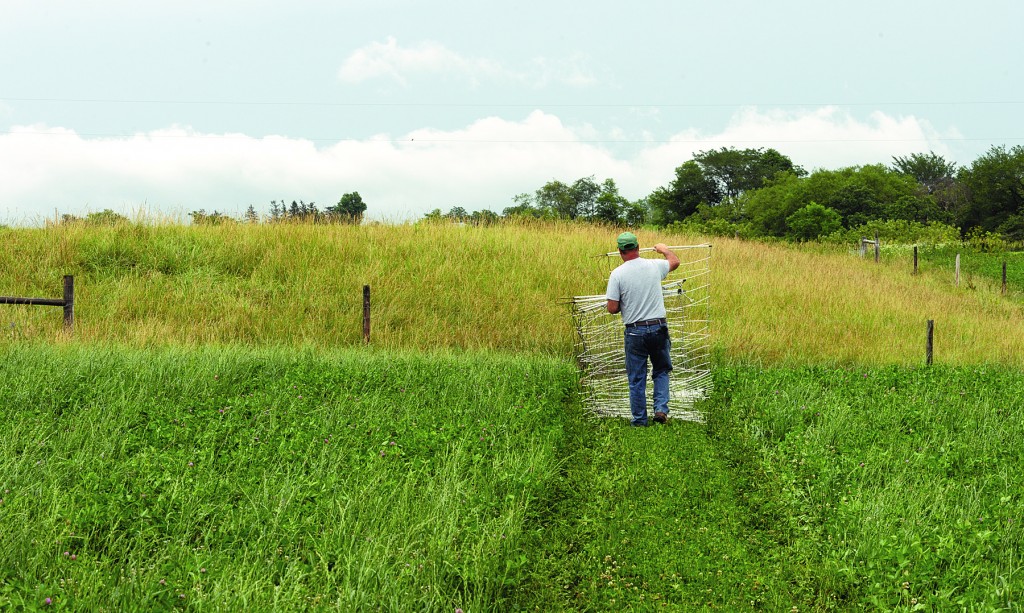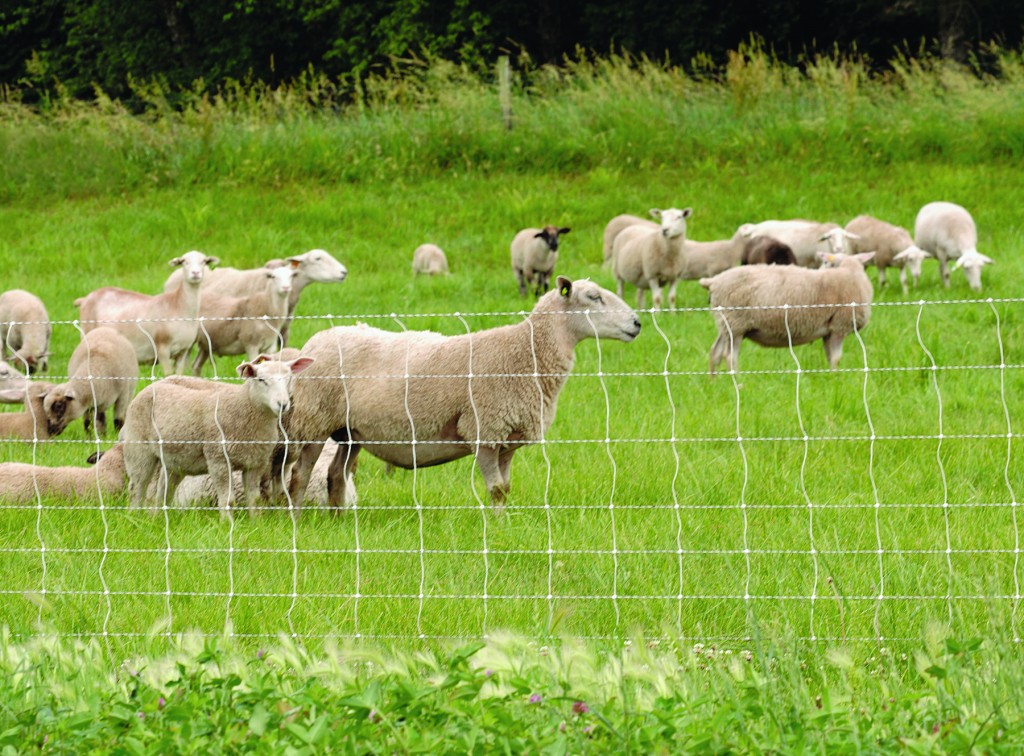Rotational grazing is the practice of moving grazing livestock between pastures (often called paddocks) as needed or on a regular basis. There are many approaches and types of grazing that fall under the broad umbrella of rotational grazing. The simplest is moving livestock between paddocks every set number of days:
- two days
- one week
- one month
But well-managed rotational grazing means that you evaluate the nutritional and forage needs of your animals, assess forage quality and quantity, regulate the acreage of access and control which parts of the pasture/range that the animals have access to.
 Many graziers use temporary electric fence systems to manage the size of the paddock. This allows the manager to control grazing and control access to forage to fit the nutritional needs of the class of livestock (e.g. lactating ewes versus dry ewes). One of the more common approaches/paradigms is termed “Management Intensive Grazing” (MiG). MiG was coined by Jim Gerrish, a well-respected grazing consultant for livestock. Others use the term “controlled grazing” to refer to fact that the livestock’s access to forage is controlled by the shepherd.
Many graziers use temporary electric fence systems to manage the size of the paddock. This allows the manager to control grazing and control access to forage to fit the nutritional needs of the class of livestock (e.g. lactating ewes versus dry ewes). One of the more common approaches/paradigms is termed “Management Intensive Grazing” (MiG). MiG was coined by Jim Gerrish, a well-respected grazing consultant for livestock. Others use the term “controlled grazing” to refer to fact that the livestock’s access to forage is controlled by the shepherd.
In the rest of this article, I briefly describe some advantages of rotational grazing approaches similar to MIG which contrasts with “continuous grazing” which is the practice of turning livestock out on a piece of pasture for the whole grazing season.
Increased forage production. The general rule of thumb is that a well managed controlled grazing program can increase quality forage production by 30-70% each year. Much of this increase in forage is accomplished by minimizing overgrazing of some plants in the pasture.
A grass or clover plant that is nibbled on every few days loses, has little time to recover from the injury insult of grazing before being injured (grazed) again. It loses root mass and energy reserves and has greatly reduced forage production over the grazing season. A plant that is able to recover from a single grazing incident for three weeks or more before being injured by grazing again has more resources to put into growth and can produce 30-70% more forage.
A grass leaf that is half an inch long has a very small “solar panel”. A grass leaf that is two inches long has a much larger area for photosynthesis and can grow much faster, recover from grazing much faster and produce much more forage over the course of the season. The rule of thumb for most plants is to not graze below a minimum of two inches (though this can vary, as bermuda grass can be grazed much lower to the ground than orchard grass or big bluestem).
A well managed grazing program on average should allow 30-70% more stock on the same acreage or a significant reduction in purchased hay for winter feeding or droughts.
Increased soil fertility. Controlled grazing does several things to improve pasture soil fertility and organic matter. Two specific things include:
- Spreading manure around the whole pasture since grazing sheep and cattle typically return to the water tanks or a single favorite shade tree. This results in the mining of minerals and nutrients from the far parts of the pasture and depositing them at the water tanks or shade trees.
- Plants that are over-grazed or less healthy from being grazed every few days have smaller root mass which leads to less soil organic matter.
Increased organic matter and soil fertility will reduce needs for purchased fertilizers, and result in increased forage production.
Increased resistance to drought. Increased soil organic matter and better forage cover due to better grazing management will slow water movement during hard rains and increase absorption of water by the soil. Decreased water run off and increased soil organic matter keep pastures more resistant to impacts of drought, increase forage production and maintain forage growth longer into periods of droughts.
Less wasting of forage. A flock of ewes or herd of cattle that are given access to 20 times as much forage as they can eat in a day or two will walk a lot of forage into the ground, defecate and spoil forage as they walk to and from the best forage spots over the 3 weeks or more that they are on the pasture time. By only providing a few days or a single day’s worth of forage, there are many fewer opportunities to walk on plants and excrete on forage making it less palatable.
Soil compaction. While less of an issue with sheep than cattle (150 lb ewe versus 1000 lb cow), walking longer distances over the same paths increases soil compaction, which decreases soil fertility, water absorption and ability of forage plant roots to penetrate the soil. Fewer days on the same paddock per year will result in less soil compaction.
Control less desirable plants. This can be done in several ways with controlled grazing. Our pastures have a couple areas of cheat grass which has a short window of decent grazing followed by many months of being dry and unpalatable with sharp pointed seeds. In many years, we are able to put the sheep on the cheat grass areas in early spring and graze them hard. Over the years, the amount of cheat grass has decreased. The ability to control paddock size can strongly encourage your sheep (or cattle) to eat the less desirable plants at the times you need them to.
Extending the grazing season by limit feeding dry ewes or early gestation ewes. Dry ewes will eat much more forage than they need to maintain body condition or to get back into breeding condition. If you give your flock of ewes a big pasture, it is like giving a child with no self-control a large bag of candy and saying you can eat one or two pieces/day. My ewes don’t listen to me when I tell them this pasture has to last you two weeks. They will eat it all in few days, even at times of the year when they don’t need as much nutrition. Controlling paddock size will decrease the amount of hay you buy or allow you to reserve more forage for the weaned lambs that are growing to market size and need much more nutrition.
Saving the best forage for the class of sheep that needs it the most. The more control a manager has over paddock size, the more he/she can put dry ewes on poorer quality forage and save the best forage for the growing lambs or the lactating ewes. This grazing approach is termed “leader – follower”. Newly weaned lambs could be put on the best forage. This allows lambs to “cherry-pick” the highest quality forage and then you can move them on to the next high forage quality paddocks. A few weeks later, dry ewes can be grazed on the same grass that has had the best forage removed by the growing lambs.
Seasonal paddocks. Certain paddocks/pastures can be seeded or developed for seasonal grazing. Many forages are cool season or warm season. Some plants tolerate freezing and other plants have little grazing value after frosts in the fall. With controlled grazing, paddocks can be developed for seasonal grazing, whereas this is much harder with a single larger pasture.
Grazing animals can be used to help prep areas for reseeding. Certain types of grass and clover seeds can be successfully broadcast on top of the ground without tilling the seeds into the soil. A grass manager can use a group of sheep to slightly overgraze an area to expose a little soil and cut down on the grass cover. Then more of the broadcast seeds fall on bare soil and are more likely to germinate. If the sheep are kept on the area with the broadcast for a day or two, their hooves can be used to help press the seed into contact with the soil. This is best done just prior to a rain.
Limit feeding during times of drought. During a drought, a livestock manager can control the amount of grazing and prevent a flock from eating all of the forage up, before the rains come. With adequate fencing and the ability to manipulate size of paddock with portable electric fencing, a shepherd can postpone buying hay for a few days or weeks and save funds. Of course, certain animals such as late gestation ewes or newly weaned lambs probably will need that extra forage and cannot be limit fed.
Improved animal management. Sheep and cattle that are regularly rotated to new pastures every few days in low stress procedures are much easier to manage. Open a gate and call is often all that you need to do to get the sheep or cattle to follow you to the next pasture or to the working corrals. They associate the humans with better food. If every time you show up out in the pasture you drive them to the work pens to stick them with needles or stick drench guns down their throat or castrate them, the sheep or cattle are much less likely to trust you. Stress results in weight losses and increased disease susceptibility.
Allowing certain species of plants to go to seed. Certain annual plants that reseed usually need a few weeks to develop a seed head and then time for seeds to scatter without grazing animals present. A couple of examples are annual rye grass and hairy vetch. With constant grazing, these plants never have a chance to go to seed. Our sheep eat the annual rye grass seed heads as well as the grass blades. Removing sheep from rye grass pastures in late spring/early summer will allow them to go to seed.
Keep stands of favorite forage species. Sheep and cattle will continually graze preferred and tasty plants every few days, for example, legumes (grazing alfalfas or clovers) and favorite grasses. With continuous grazing and over a few years the favorite species die out and the less tasty species increase. Putting a mob of sheep into a smaller paddock for a day or two, with a limited amount of forage, encourages the sheep to graze both the plants they love as well as the ones they do not like as well. When the flock is moved to the next paddock, the favorite clover plants are allowed to grow and not be grazed to death every few days.
Late winter/early spring grazing. Just a little bit of controlled grazing can have a significant impact on the amount of hay fed in the winter. In late winter, a grazing mentor of mine would start saying it is time to shut the gates. Shut the gates! If your sheep have access to whole pasture all winter, every time there is a little green, they will bite off that leaf. That little bit of grass does help the sheep and decreases hay consumption. On the other hand, if you pen the sheep up right at the end of winter, in two weeks you can quit feeding hay. Do the math: a month of feeding a little less hay (let’s say 80% of peak winter hay) or two weeks of feeding slightly more hay (100% of peak winter hay levels) while they are in the pen. A 2 inch blade of grass can grow an extra two inches of blade length in one-half to one fourth of the time it takes a 1/2 inch blade of grass to grow 2 extra inches when there is enough moisture and sunlight.
Animal assessment. Moving the sheep every day or even every week to a new pasture allows the shepherd to assess animal health. Lagging animals are noticed when they all surge past the gate where the shepherd is standing. In parasite season, here in the Southeast, the slow moving lambs are candidates for being anemic and worm ridden. If a shepherd feeds some grain every day and calls the lambs or ewes in from pasture, the same ability to assess animal health as they move can be achieved.
Trade-offs and costs of Rotational Grazing. The manager has to consider the expenses of rotational grazing into consideration, including more fencing costs, more labor, and usually a more expensive water system. One also needs to have portable mineral tubs and guardian animals that move with the sheep. The sheep may not have access to shelter and a shepherd might have to hurry home from other work during a November day with an early blizzard to get the sheep off the exposed hill paddock. By contrast, in a continuous grazing system the sheep would likely have moved to the sheltered part of the pasture on their own.
In summary, controlled rotational grazing has many advantageous. A shepherd has to determine whether it works for their system. Two key advantages in our farm’s system are the 30-70% increase in forage production and the ability to control and limit feed dry ewes and early gestation ewes. The ability to limit graze the classes of sheep that don’t need unlimited access to forage and would eat more than they need, greatly decreases the amount of hay we feed and purchase. We also appreciate that the sheep handle much easier, reducing stress on the people and the flock.
A few Resources for Managed Grazing include:
www.attra.ncat.org – Several publications on fencing and grazing. Print from the website or call 800-346-9140 for free publications with information on sustainable sheep raising, managed grazing and sheep fencing for managed grazing.
www.stockmangrassfarmer.com – Stockman Grass Farmer (SGF). A monthly publication. 800-748-9808 or sgfsample@aol.com for a sample copy or a subscription
Management-intensive Grazing: The Grassroots of Grass Farming. 2004. Jim Gerrish. Green Park Press. An excellent book for the beginner and experienced alike covering soils, management, forages, etc. Order Jim Gerrish directly at www.americangrazinglands.com or from the SGF website, www.stockmangrassfarmer.com (look for the link to Bookshelf) or call 800-748-9808.
Local County Extension and USDA-NRCS (Natural Resource Conservation Service) offices. Each state has experts on grazing and forages. Some staff can provide good small ruminant advice, or if not, get them to talk beef cattle — you can then make the small conversions needed to make the beef advice work for sheep.


